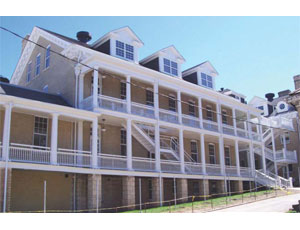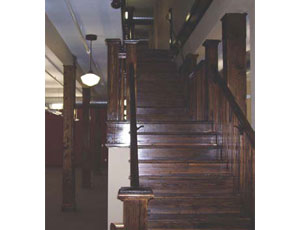... painting and pigment qualities,” Holman says. “In another building, we used as one of the focal points the old nurses stations. We framed around that and kept the station, using the area behind as the sanctuary for copiers, etc.”


In some areas, raised bed floors provided the perfect area to run ductwork, electrical and telecommunications.
To achieve the LEED-silver requirements, JPMO stipulated a lot of reuse of original materials. “Preplanning allowed us to use as many materials as possible,” Holman says. “If we could deconstruct and make use of those materials, that was our first choice.”
Marrying the historic renovation to implosion-resistance standards was a challenge for RKJ Construction Inc. of Lampasas, Texas, which currently holds several historic renovation contracts at Fort Sam Houston.
“On the wood-frame structures that were built in the early 1900s, we had to run rods to bolts in the floor down the exterior walls to support them and then run bracing on existing floors to tie the walls together,” says Rex Johnson, RKJ president. “All the exterior windows have to match the style of the old windows, but be blast resistant, so we have to meet a higher psi on the window frames and glass and reinforce openings to meet that criteria.”
RKJ hired a blast-design engineer and coordinated with the architect designing the floor plans. Achieving LEED-silver is a challenge with historic renovations as well, Johnson says. “To match old doors, windows and trim, you have to have someone who can do specialty millwork,” he says.
The JPMO and Fort Sam Houston folks streamlined things for contractors, says Bobby Greaves, vice president of operations for JSR Inc. of Schertz, which holds a $5.9-million contract for renovation of Buildings 601 and 602. “Fort Sam is a good group, and works to get contractors what they need, so it’s not as difficult as it would be with other contractors,” Greaves says.
And because of the recession, contractors have their pick of good subcontractors, Greaves says. He adds that San Antonio contractors are faring better than in other parts of the country, largely because of the military work. “It’s not all doom and gloom,” Greaves says. “Our guys see packages weekly. Military work is a large chunk of our business, about 50%.”
Foreseeing how much business would be flooding the area, (roughly $1.2 billion in fiscal year 2008 and $700 million in FY 2009 when the historic norm is $65 million-$100 million annually) the JPMO partnered with the city of San Antonio’s Office of Military Affairs, Bexar County and the local business community to support the ongoing program with an online storyboard.
Implemented in April 2008, the storyboard (found at www.sanantonio.gov/oma) allows contractors to see an 18-month outlook of the program, including project descriptions, range of contracts, contracting mechanisms and award dates, Dwyer says. “The storyboard allows contractors to develop a plan, and we get a better product because people have had time to prepare for when the announcement comes through FedBizOpps,” he adds.
Most of the renovation projects at Fort Sam Houston will be complete by mid- to late-2011. The final projects will be awarded in fall 2010.


Post a comment to this article
Report Abusive Comment